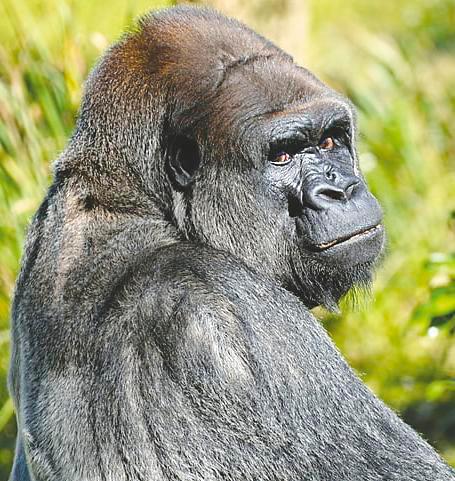HAVE you ever wondered what it is like to stand face to face with a creature so powerful yet so human in its gaze?
Imagine being in the heart of Africa’s mystical forests surrounded by towering trees and the ethereal sounds of nature, and you find yourself in the presence of gorillas.
What is it like to share a connection with these gentle giants that are our kin in the animal kingdom, and hold a mirror to our humanity?
These are not just creatures of the wild; they are living legends, each with their own unique story.
Gorillas, magnificent forest guardians, have long captured our imagination with their immense strength and remarkable intelligence. There is the Eastern Gorilla (Gorilla beringei) and the Western Gorilla (Gorilla gorilla), boasting their unique charm.
In the heart of Africa, the Eastern Gorilla can be divided into two distinct species: the Mountain Gorilla, shrouded in the mists of the Virunga Mountains, and the Eastern Lowland Gorilla, a giant of the lush, lowland rainforests.
On the other side of the continent, the Western Gorilla reigns supreme, with the Western Lowland Gorilla reigning in the vast lowland forests, and the Cross River Gorilla, fighting for survival on the border between Nigeria and Cameroon.
In recent years, the fate of these incredible creatures has hung in the balance. The Mountain Gorilla population has shown signs of a miraculous resurgence, with roughly 1,000 spotted in a recent count.
In stark contrast, the Eastern Lowland Gorilla faces an alarming decline, with fewer than 6,800 navigating a perilous path through a landscape marred by habitat loss and poaching.
The Western Lowland Gorillas, with an estimated 150,000-250,000, are far from secure, grappling with the ever-encroaching threats of habitat degradation and disease. The Cross River Gorilla remains a rare gem, with just 200 to 300 clinging to the brink of extinction.
This tapestry of gorilla diversity is fraying at the edges, with all four subspecies listed as endangered or critically endangered by the International Union for Conservation of Nature.
The reasons for their decline are all too familiar: deforestation, mining, agriculture and the relentless illegal trade in bushmeat and live animals.
Threats, challenges and conservation efforts
The decline of gorilla populations is a tragic consequence of many interconnected factors. One of the main contributors is habitat destruction due to deforestation, mining activities and agricultural expansion.
As human populations grow, pristine forests are cleared for settlements and agriculture, leaving gorillas with dwindling territories. This habitat loss disrupts their foraging grounds and fragments their communities, making it more challenging for gorillas to find adequate food and maintain healthy social structures.
Compounding this issue is the insidious illegal wildlife trade. Gorillas are targetted for their bushmeat and captured for the pet trade or the entertainment industry.
Poaching takes a heavy toll on their numbers as they are killed or captured in alarming numbers, adding to their peril.
Furthermore, disease outbreaks, often linked to human interaction, threaten gorillas, especially the spread of illnesses, such as Ebola.
The entire population of what was once the world’s second-largest protected community of gorillas and chimpanzees was wiped out by the 1994 outbreak in Minkebe, in northern Gabon. These multifaceted threats cast a shadow of uncertainty over the future of these incredible beings.
Central to the survival of gorillas are the dedicated and tireless efforts of conservation organisations that have made it their mission to protect these magnificent creatures and their habitats.
The Dian Fossey Gorilla Fund is a beacon of hope among these organisations. Named after the renowned primatologist Dian Fossey, whose groundbreaking work with Mountain Gorillas inspired countless others, the organisation conducts a multifaceted approach to gorilla conservation.
They have forged a path toward coexistence through scientific research, anti-poaching measures and community engagement. Their work not only safeguards gorillas but also empowers local communities, ensuring that the well-being of humans and gorillas is intertwined.
Additionally, the Jane Goodall Institute, famous for its work with chimpanzees, extends its dedication to gorilla conservation through community-based programmes that reduce poaching and habitat destruction while promoting sustainable livelihoods.
These organisations, along with others, such as the World Wildlife Fund and the African Wildlife Foundation, play pivotal roles in protecting these great apes, reminding us that collective action is essential to secure the future of these extraordinary beings.
As Dian Fossey, the tireless guardian of Mountain Gorillas, once said: “When you realise the value of all life, you dwell less on what is past and concentrate more on the preservation of the future.”
Her words echo through time, a poignant reminder of the urgency that surrounds gorilla conservation. Their future is the mirror in which we see the value we place on all life, a reflection of our commitment to preserving the intricate web of existence that sustains us.
With their strength, gentle souls and resolute spirit, gorillas call upon us to protect their world – a world that is, ultimately, our shared heritage.
The writer is the founder and chief executive officer of BioDB.com, a group tasked with collecting conservation data, raising awareness for biodiversity loss and fundraising. Comments: letters@thesundaily.com









